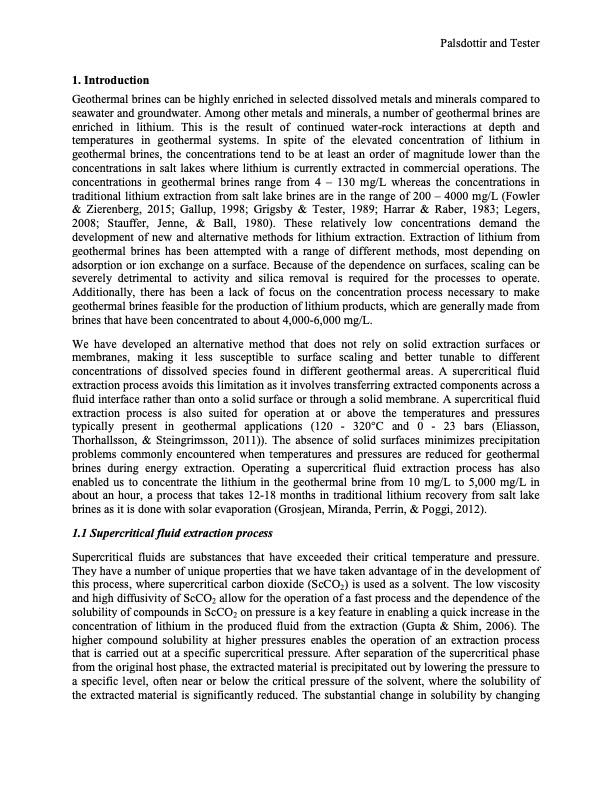
PDF Publication Title:
Text from PDF Page: 002
1. Introduction Geothermal brines can be highly enriched in selected dissolved metals and minerals compared to seawater and groundwater. Among other metals and minerals, a number of geothermal brines are enriched in lithium. This is the result of continued water-rock interactions at depth and temperatures in geothermal systems. In spite of the elevated concentration of lithium in geothermal brines, the concentrations tend to be at least an order of magnitude lower than the concentrations in salt lakes where lithium is currently extracted in commercial operations. The concentrations in geothermal brines range from 4 – 130 mg/L whereas the concentrations in traditional lithium extraction from salt lake brines are in the range of 200 – 4000 mg/L (Fowler & Zierenberg, 2015; Gallup, 1998; Grigsby & Tester, 1989; Harrar & Raber, 1983; Legers, 2008; Stauffer, Jenne, & Ball, 1980). These relatively low concentrations demand the development of new and alternative methods for lithium extraction. We have developed an alternative method that does not rely on solid extraction surfaces or membranes, making it less susceptible to surface scaling and better tunable to different concentrations of dissolved species found in different geothermal areas. A supercritical fluid extraction process avoids this limitation as it involves transferring extracted components across a fluid interface rather than onto a solid surface or through a solid membrane. A supercritical fluid extraction process is also suited for operation at or above the temperatures and pressures typically present in geothermal applications (120 - 320°C and 0 - 23 bars (Eliasson, Thorhallsson, & Steingrimsson, 2011)). The absence of solid surfaces minimizes precipitation problems commonly encountered when temperatures and pressures are reduced for geothermal brines during energy extraction. Operating a supercritical fluid extraction process has also enabled us to concentrate the lithium in the geothermal brine from 10 mg/L to 5,000 mg/L in about an hour, a process that takes 12-18 months in traditional lithium recovery from salt lake brines as it is done with solar evaporation (Grosjean, Miranda, Perrin, & Poggi, 2012). 1.1 Supercritical fluid extraction process Palsdottir and Tester Extraction of lithium from geothermal brines has been attempted with a range of different methods, most depending on adsorption or ion exchange on a surface. Because of the dependence on surfaces, scaling can be severely detrimental to activity and silica removal is required for the processes to operate. Additionally, there has been a lack of focus on the concentration process necessary to make geothermal brines feasible for the production of lithium products, which are generally made from brines that have been concentrated to about 4,000-6,000 mg/L. Supercritical fluids are substances that have exceeded their critical temperature and pressure. They have a number of unique properties that we have taken advantage of in the development of this process, where supercritical carbon dioxide (ScCO2) is used as a solvent. The low viscosity and high diffusivity of ScCO2 allow for the operation of a fast process and the dependence of the solubility of compounds in ScCO2 on pressure is a key feature in enabling a quick increase in the concentration of lithium in the produced fluid from the extraction (Gupta & Shim, 2006). The higher compound solubility at higher pressures enables the operation of an extraction process that is carried out at a specific supercritical pressure. After separation of the supercritical phase from the original host phase, the extracted material is precipitated out by lowering the pressure to a specific level, often near or below the critical pressure of the solvent, where the solubility of the extracted material is significantly reduced. The substantial change in solubility by changingPDF Image | Mining the Future Lithium

PDF Search Title:
Mining the Future LithiumOriginal File Name Searched:
1034174.pdfDIY PDF Search: Google It | Yahoo | Bing
Product and Development Focus for Infinity Turbine
ORC Waste Heat Turbine and ORC System Build Plans: All turbine plans are $10,000 each. This allows you to build a system and then consider licensing for production after you have completed and tested a unit.Redox Flow Battery Technology: With the advent of the new USA tax credits for producing and selling batteries ($35/kW) we are focussing on a simple flow battery using shipping containers as the modular electrolyte storage units with tax credits up to $140,000 per system. Our main focus is on the salt battery. This battery can be used for both thermal and electrical storage applications. We call it the Cogeneration Battery or Cogen Battery. One project is converting salt (brine) based water conditioners to simultaneously produce power. In addition, there are many opportunities to extract Lithium from brine (salt lakes, groundwater, and producer water).Salt water or brine are huge sources for lithium. Most of the worlds lithium is acquired from a brine source. It's even in seawater in a low concentration. Brine is also a byproduct of huge powerplants, which can now use that as an electrolyte and a huge flow battery (which allows storage at the source).We welcome any business and equipment inquiries, as well as licensing our turbines for manufacturing.| CONTACT TEL: 608-238-6001 Email: greg@infinityturbine.com | RSS | AMP |